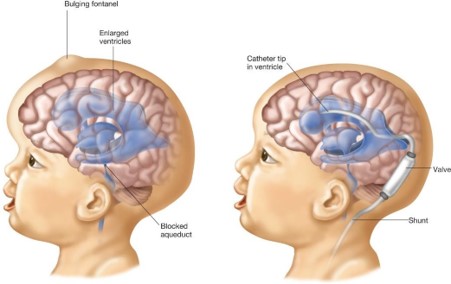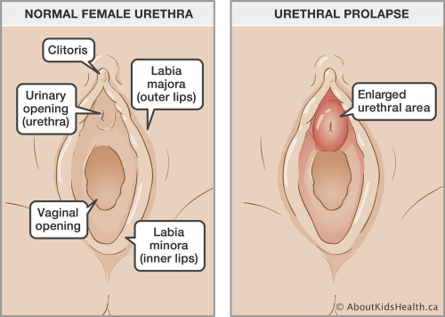When a 2-week-old infant is seen for irritability, poor appetite, and rapid head growth with observable distended scalp veins, the nurse recognizes these signs as indicative of which disorder?
Cerebral palsy
Syndrome of inappropriate antidiuretic hormone (SIADH)
Hydrocephalus
Reye's syndrome
The Correct Answer is C
Hydrocephalus refers to a condition characterized by an abnormal accumulation of cerebrospinal fluid (CSF) within the ventricles of the brain. In infants, hydrocephalus can cause the head to enlarge rapidly as a result of the increased pressure exerted by the accumulating fluid. This is known as "rapid head growth." The increased intracranial pressure canlead to irritability and poor appetite in infants.
The distended scalp veins are another common sign of hydrocephalus. As the fluid accumulates, it puts pressure on theblood vessels in the brain, causing the veins in the scalp to become more visible and distended.
Cerebral palsy in (option A) is incorrect because is a neurological disorder that affects body movement and musclecoordination, but it does not typically present with rapid head growth or distended scalp veins.
Syndrome of inappropriate antidiuretic hormone (SIADH) in (option B) is incorrect because it is a condition characterized by excessive secretion of antidiuretic hormone, leading to fluid imbalance, but it does not usually cause rapid head growth or distended scalp veins. Reye's syndrome (D) is a rare condition that primarily affects the liver and brain, and it does not typically present with rapid head growth or distended scalp veins.
Therefore, based on the signs described, hydrocephalus (C) is the most likely disorder in this case. It is important to seekmedical attention promptly for a proper diagnosis and appropriate management of hydrocephalus in infants.

Nursing Test Bank
Naxlex Comprehensive Predictor Exams
Related Questions
Correct Answer is C
Explanation
In the given scenario, the 6-year-old patient in skeletal traction is experiencing
pain, edema, and fever. These symptoms raise concerns about the possibility of an infection
at the site of traction. In such cases, the nurse should assess for warmth at the site of pain.
Increased warmth can indicate inflammation, which may be associated with infection. This
assessment finding would require further investigation and intervention, such as notifying the
healthcare provider and obtaining appropriate cultures or imaging studies.
Neurologic status in (Option A) is incorrect because assessing neurologic status, is important
but not the priority in this scenario. Neurologic status assessment is typically performed to
evaluate any neurovascular compromise resulting from the traction, but the presence of pain,
edema, and fever suggests a potential infection that requires immediate attention.
Range of motion of all extremities in (Option B) is incorrect because assessing the range of
motion of all extremities, is not directly relevant to the given symptoms and should not take
priority over assessing for warmth at the site of pain.
Blood pressure in (Option D) is incorrect because assessing blood pressure, is not directly
related to the symptoms of pain, edema, and fever in the context of skeletal traction. While
blood pressure is an essential vital sign, it does not provide specific information about the
potential infection at the site of pain in this situation.
Correct Answer is B
Explanation
The anatomy of the urinary tract can influence the susceptibility to urinary tract infections (UTIs). In the case of young girls, their urethra is shorter compared to adult females, which increases the likelihood of bacteria reaching the bladder. The shorter urethra provides a shorter distance for bacteria to travel from the outside of the body to the bladder, making it easier for bacteria to enter and cause an infection.
Prostatic secretions in males in (option A) is incorrect because they are not directly related to the increased susceptibility to UTIs. Prostatic secretions can, however, contribute to conditions like prostatitis, which is an inflammation of the prostate gland that can be associated with urinary symptoms and sometimes bacterial infections.
Frequent emptying of the bladder in (option C) is incorrect because it is generally considered a healthy practice as it helps to flush out any potential bacteria in the urinary tract. It does not predispose the urinary tract to infection.
Increased fluid intake in (option D) is incorrect because it is generally encouraged to maintain proper hydration and urinary tract health. It can help to flush out bacteria from the urinary system, reducing the risk of infection.
While these factors may have implications for urinary tract health, the specific factor that predisposes the urinary tract to infection, particularly in young girls, is the short urethra (B).

Whether you are a student looking to ace your exams or a practicing nurse seeking to enhance your expertise , our nursing education contents will empower you with the confidence and competence to make a difference in the lives of patients and become a respected leader in the healthcare field.
Visit Naxlex, invest in your future and unlock endless possibilities with our unparalleled nursing education contents today
Report Wrong Answer on the Current Question
Do you disagree with the answer? If yes, what is your expected answer? Explain.
Kindly be descriptive with the issue you are facing.
